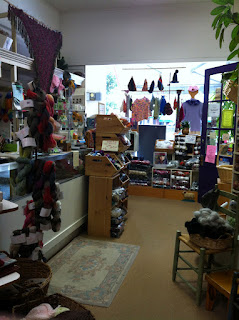 |
| The Woolly Lamb, 712 Main Street, East Aurora, NY |
It was!
I was greeted upon entering - as I would expect, so that was nice. Some places do not do this, by the way.
My first impression of the store was that it was a bit on the sloppy side. There were some areas where the yarns were piled on top of each other and in boxes and bags. Nothing wrong with having extra in the bags, but it is nice to see them stacked nicely in my opinion. I like to see a knitting shop that is neat and organized because it makes finding what I want much easier; also if a yarn is new to me, I am much more likely to check it out if I don't have to dig underneath another bag of yarn to get to it.
The shop has an excellent selection of yarn and a pretty nice selection of notions. The woman who was there was very friendly and helpful. I witnessed great treatment to another customer who had come in after me. She was looking for a certain yarn that she had purchased before, but didn't have the ball band or something like that, and the shop lady was helpful in trying to find it for her. I also heard the customer ask what time the store opened, and the shop lady said 11 but that she was often late.
This late bit I find kind of a bad business practice, but hey. It isn't my store. I am sure there usually isn't a line waiting for the place to open, however if your hours are 11 to whenever, then you should be there at that time. I was ready to leave, and she would have missed out on my purchase.
At any rate, despite the few negatives I mentioned above, I would definitely go back to this store. Good customer service far outweighs opening a few minutes late and being a little bit messy. If you are in the area of East Aurora NY, I recommend stopping by The Woolly Lamb. I even got an ink pen :0)
My purchase? I got some Sublime angora merino - it was on sale! So absolutely soft and wonderful, I can't wait to start knitting with it.
Below are a few pictures of the store, and the yarn I got.

































